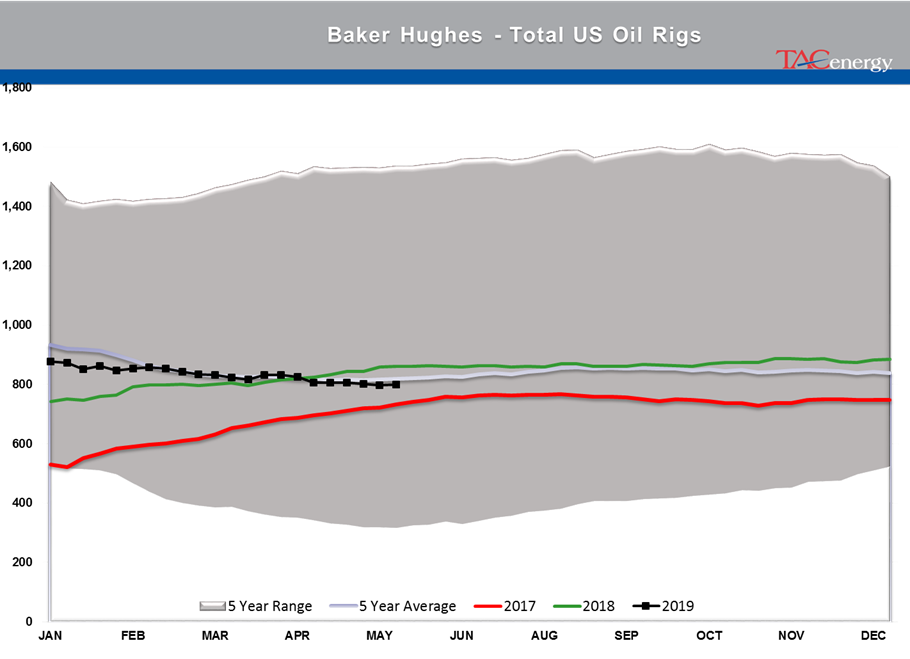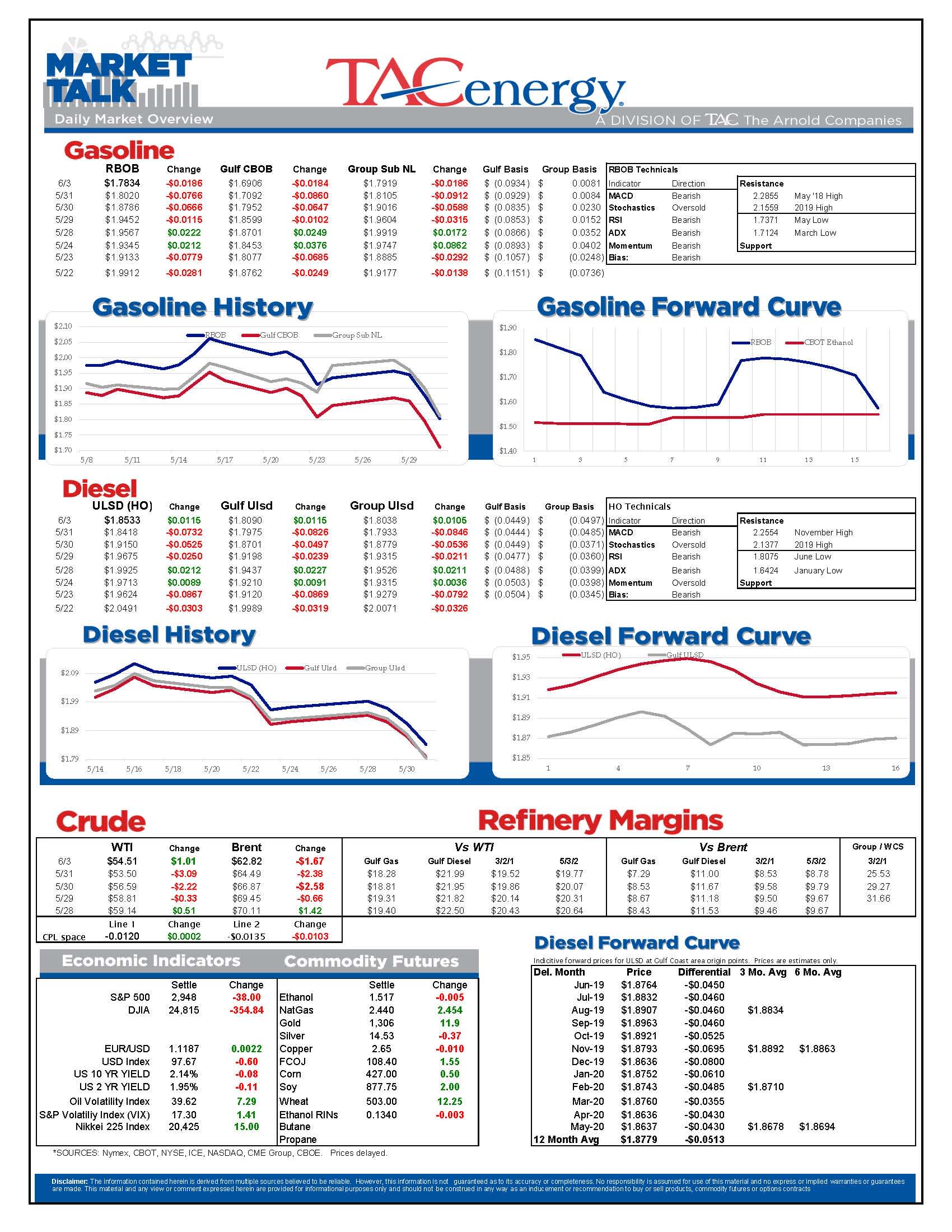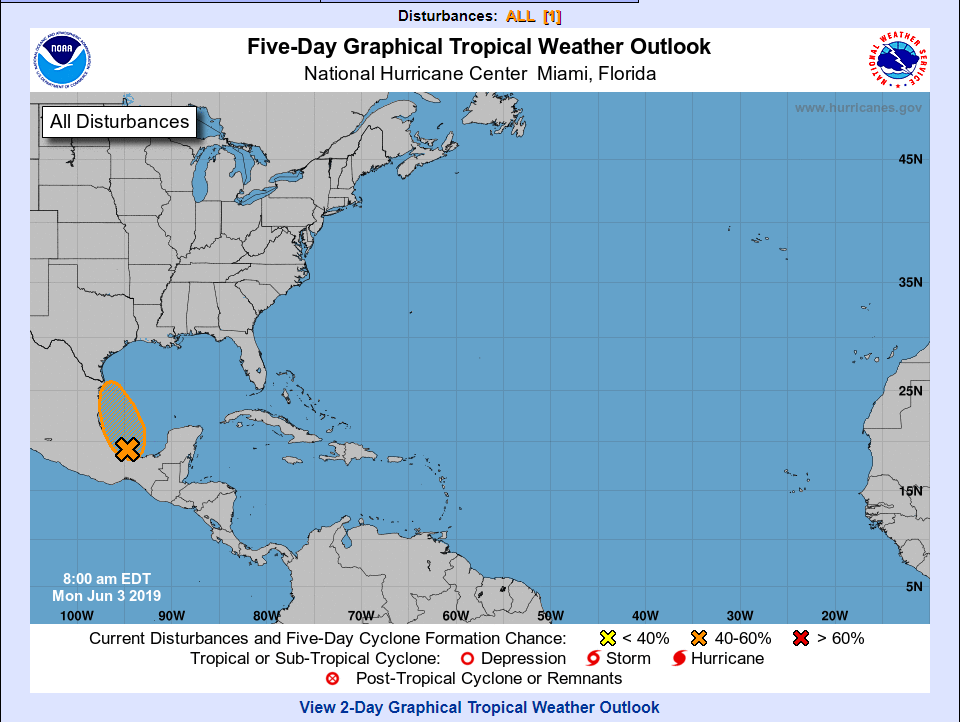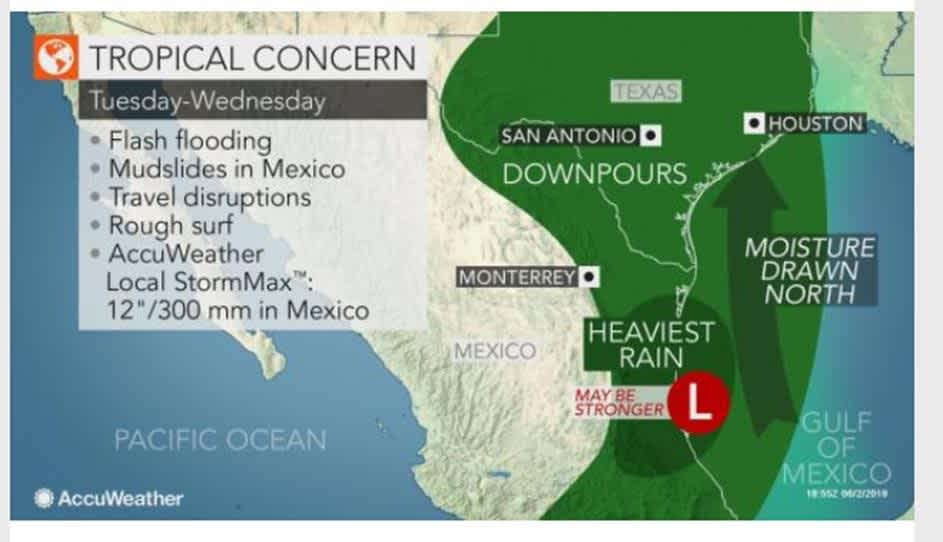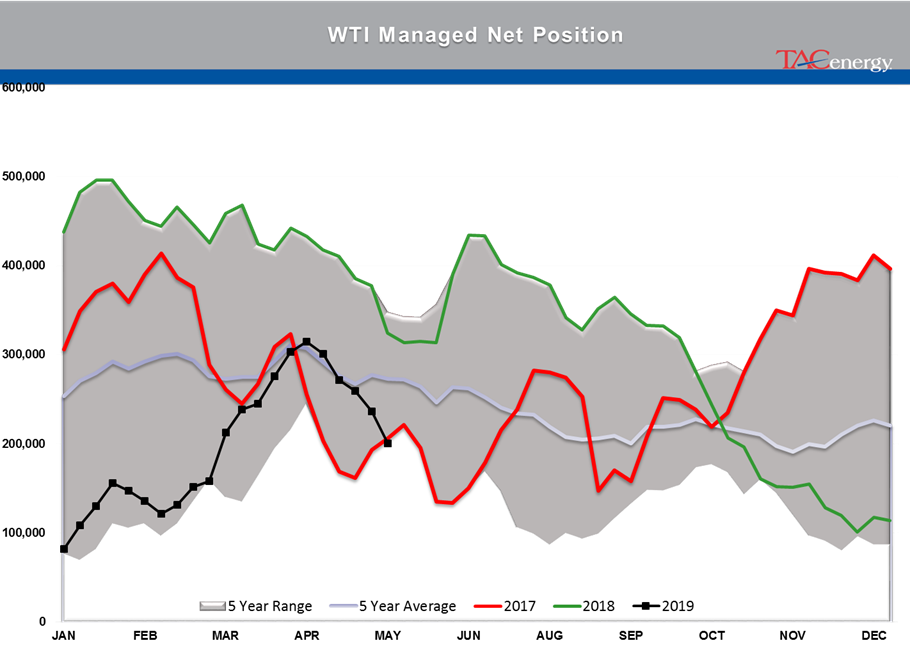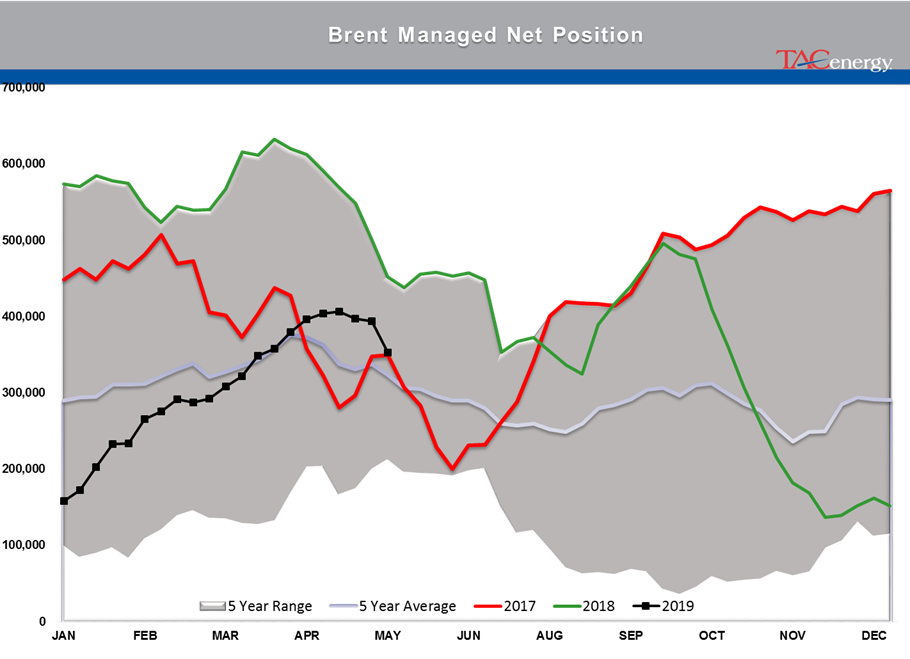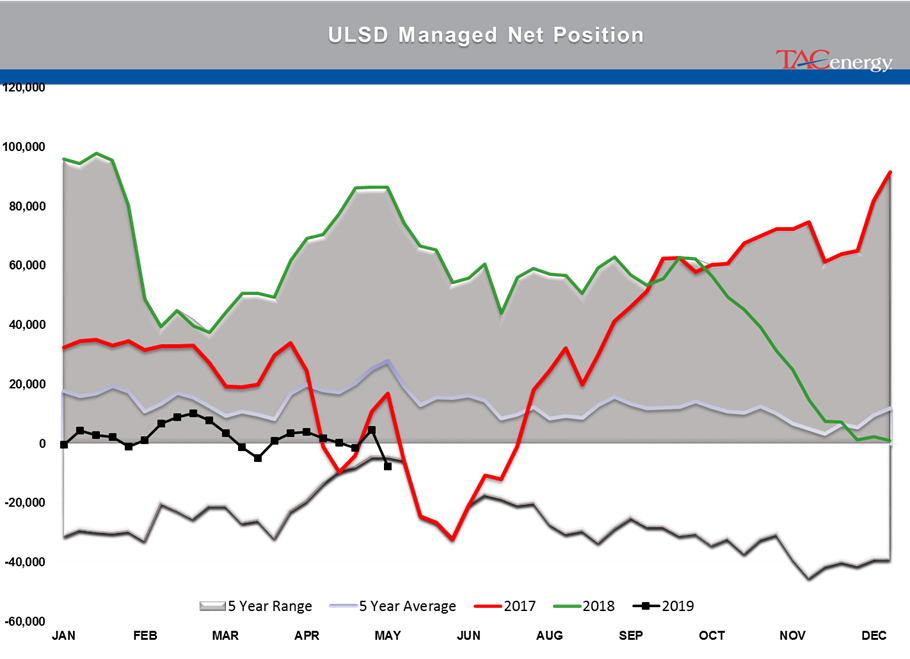Energy Markets Dig In Heels After Brutal May

Energy markets are attempting to dig in their heels after a brutal May that knocked 12-16% off of prices. Overnight it appeared that the May sell-off would carry over through June as oil futures were down $1.5 and refined products were down another 3+ cents, but they managed to find a bottom around 3am and have been rising steadily since. The rebound coincided with comments from the Saudi energy minister pledging to draw down global inventories from elevated levels.
With most of the year’s gains wiped out in the past 2 weeks, there is little doubt that the 2019 bull market for energy prices has come to an end. The big question now is whether a new bear market is just beginning, or if we’ll enter another extended period of sideways trading. The first test in determining that looks to be chart support near the overnight lows at $60 for Brent & $52 for WTI, while RBOB faces a good test at its March lows of $1.71, and ULSD looks like it has room to fall all the way to its January lows of $1.64.
The 2019 Atlantic Hurricane season officially started on Saturday, and already there’s a storm system in the Gulf of Mexico that has a chance at becoming a named storm heading towards the Texas coast this week. Currently the National Hurricane Center is giving this storm a 60% chance of development (it will be named Barry if it reaches storm status) and while it may not have enough time over the water to develop into anything major, there’s a decent chance this storm will bring more flooding rains to a swath of TX, AR and LA that are already fighting high water levels.
The latest COT data (collected as of Tuesday May 28) shows that the liquidation in the managed money category picked up in earnest, with WTI, Brent and RBOB all seeing their largest weekly reductions in net-length of the year, while ULSD contracts fell back into a net-short position. Based on the price drops we saw in the back half of last week, it seems likely we could see an even larger reduction in speculative bets on higher prices in this week’s COT report.
Baker Hughes reported an increase of 3 oil rigs drilling in the US last week, with the total count regaining the 800 rig mark after dipping below that level last week for the first time since March 2018.
Latest Posts
The Struggle For Renewable Producers Continues As A Rapid Influx Of Supply And Crashing Credit Prices Make Biodiesel
After Years Of Backwardation, Diesel Prices Have Slipped Into Contango Over The Past Week
Gasoline Futures Are Leading The Way Lower This Morning
The Sell-Off Continues In Energy Markets, RBOB Gasoline Futures Are Now Down Nearly 13 Cents In The Past Two Days
Social Media
News & Views
View All
The Struggle For Renewable Producers Continues As A Rapid Influx Of Supply And Crashing Credit Prices Make Biodiesel
The sigh of relief selloff continues in energy markets Tuesday morning, with gasoline prices now down more than 20 cents in 7 sessions, while diesel prices have dropped 26 cents in the past 12. Crude oil prices are within a few pennies of reaching a 1 month low as a lack of headlines from the world’s hot spots allows some reflection into the state of the world’s spare capacity for both oil and refined products.
Gasoline prices are trading near a 6-week low this morning, but still need to fall about another nickel in order to break the weekly trendline that pushed prices steadily higher since December. If that trend breaks, it will be safer to say that we saw the end of the spring gasoline rally on April 12th for the 2nd year in a row. Last year RBOB futures peaked on April 12 at $2.8943 and bottomed out on May 4th at $2.2500. The high (at this point) for this year was set on April 12th at $2.8516, and the low overnight was $2.6454.
It’s not just energy commodities that are seeing an unwind of the “flight to safety” trade: Gold prices had their biggest selloff in 2 years Monday and continue to point lower today. Just how much money poured into commodities in the weeks leading up to the direct confrontation between Israel and Iran is unclear, but we have seen in year’s past that these unwind-events can create a snowball effect as traders can be forced to sell to cover their margin calls.
Supply > Demand: The EIA this morning highlighted the record setting demand for natural gas in the US last year, which was not nearly enough to offset the glut of supply that forced prices to a record low in February. A shortage of natural gas in Europe was a key driver of the chaotic markets that smashed just about every record in 2022, and an excess of natural gas supply in Europe and the US this year is acting as a buffer, particularly on diesel prices.
The struggle for renewable producers continues as a rapid influx of supply and crashing credit prices make Biodiesel, RD and SAF unprofitable for many. In addition to the plant closures announced in the past 6 months, Vertex Energy reported Monday it’s operating its Renewable Diesel facility in Mobile AL at just 50% of capacity in Q1. The truly scary part for many is that the $1/gallon Blender's tax credit ends this year and is being replaced by the “Clean” Fuel production credit that forces producers to prove their emissions reductions in order to qualify for an increased subsidy. It’s impossible to say at this point how much the net reduction will be for domestic producers, but importers will get nothing, and at current CI values, many biodiesel producers may see their “blend credit” cut by more than half.
Click here to download a PDF of today's TACenergy Market Talk.

After Years Of Backwardation, Diesel Prices Have Slipped Into Contango Over The Past Week
The pullback continues for energy prices as violence in the Middle East looks like it won’t rapidly expand, and financial markets continue to struggle with a higher-for-longer interest rate reality.
After years of backwardation, diesel prices have slipped into contango over the past week, despite multiple canal disruption concerns of reduced exports coming out of Russia. A Reuters article highlights how sluggish demand in Europe, and a glut of Asian supply [thanks to the rapid influx of new refining capacity over the past 2 years] is contributing to the changing market structure. This sudden weakness in diesel is also leading many refiners to reconsider their max-diesel output stance that had been key to their record setting margins in 2022 and 2023.
Money managers were reducing their bets on higher energy prices last week, in what appears to be an unwind of the positions added the prior week when it seemed like we might have an all-out war between Israel and Iran. The exception to the reduction in speculative length was the Brent crude oil contract which saw its money manager positions increase for a 4th week to reach a 3-year high. Open interest in crude oil contracts is also increasing to multi-year highs as new money flows into the energy space as a hedge of both inflation and geopolitical concerns, which could contribute to a tick higher in volatility if the sell-off continues this week as the bandwagon jumpers may soon be looking for a new ride.
Baker Hughes reported a net increase of 5 oil rigs drilling in the US last week, while natural gas rigs dropped by 2 on the week to a fresh 2 year low. The Permian basin has quietly added 8 more rigs in the past 4 weeks as producers in that region try to find a way around the shipping bottlenecks to get their otherwise profitable production to market. An RBN note last week highlighted how the lack of natural gas pipeline capacity will limit crude oil production capacity in the basin, and Kinder Morgan highlighted the need for another pipe in its latest earnings call.
Valero reported an upset at its Corpus Christi West refinery Saturday, although it appears that the brief flaring didn’t reduce operational levels.
Click here to download a PDF of today's TACenergy Market Talk.

Gasoline Futures Are Leading The Way Lower This Morning
It was a volatile night for markets around the world as Israel reportedly launched a direct strike against Iran. Many global markets, from equities to currencies to commodities saw big swings as traders initially braced for the worst, then reversed course rapidly once Iran indicated that it was not planning to retaliate. Refined products spiked following the initial reports, with ULSD futures up 11 cents and RBOB up 7 at their highest, only to reverse to losses this morning. Equities saw similar moves in reverse overnight as a flight to safety trade soon gave way to a sigh of relief recovery.
Gasoline futures are leading the way lower this morning, adding to the argument that we may have seen the spring peak in prices a week ago, unless some actual disruption pops up in the coming weeks. The longer term up-trend is still intact and sets a near-term target to the downside roughly 9 cents below current values. ULSD meanwhile is just a nickel away from setting new lows for the year, which would open up a technical trap door for prices to slide another 30 cents as we move towards summer.
A Reuters report this morning suggests that the EPA is ready to announce another temporary waiver of smog-prevention rules that will allow E15 sales this summer as political winds continue to prove stronger than any legitimate environmental agenda. RIN prices had stabilized around 45 cents/RIN for D4 and D6 credits this week and are already trading a penny lower following this report.
Delek’s Big Spring refinery reported maintenance on an FCC unit that would require 3 days of work. That facility, along with several others across TX, have had numerous issues ever since the deep freeze events in 2021 and 2024 did widespread damage. Meanwhile, overnight storms across the Midwest caused at least one terminal to be knocked offline in the St. Louis area, but so far no refinery upsets have been reported.
Meanwhile, in Russia: Refiners are apparently installing anti-drone nets to protect their facilities since apparently their sling shots stopped working.
Click here to download a PDF of today's TACenergy Market Talk.
